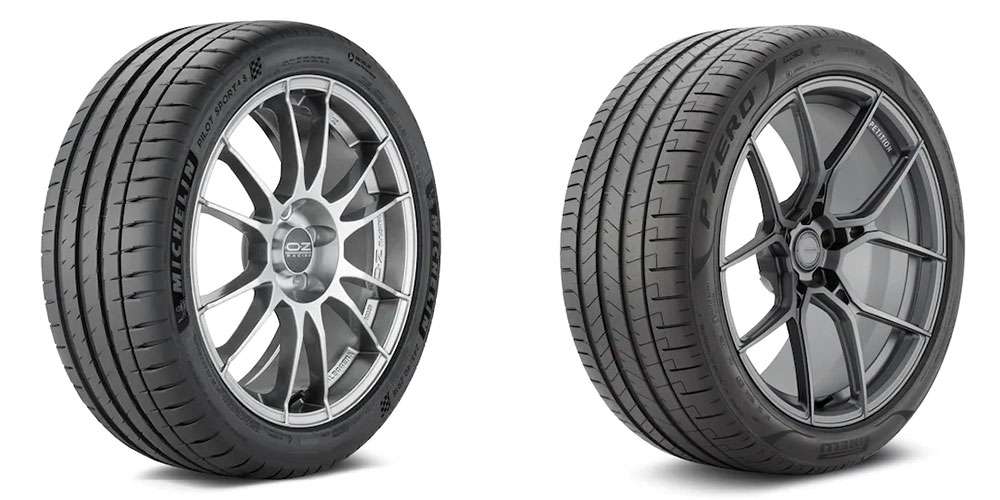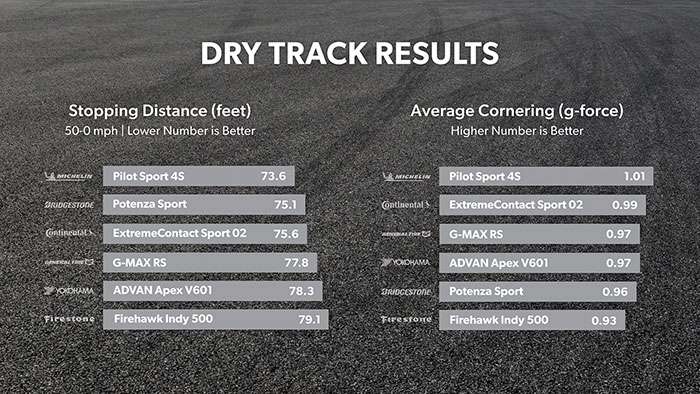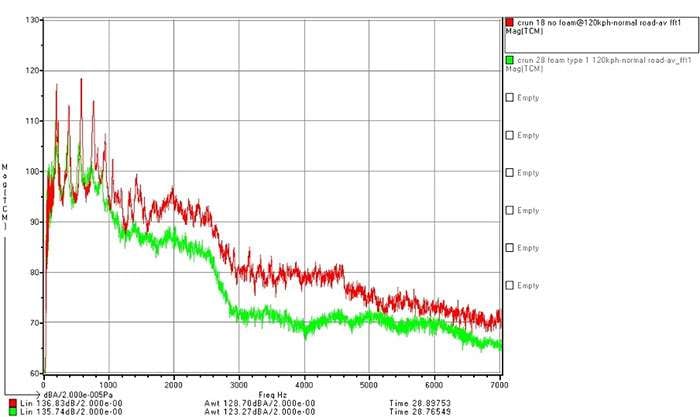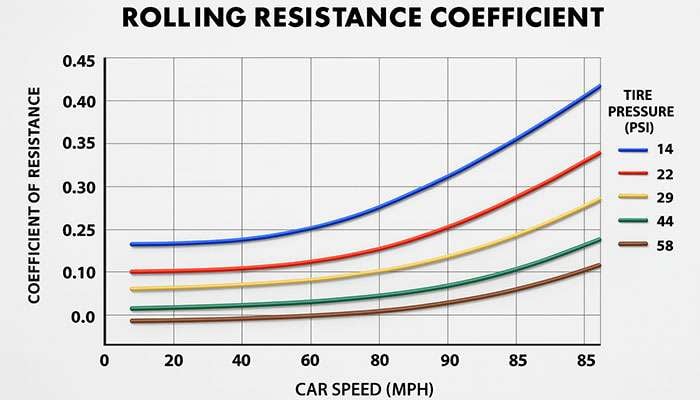
Performance enthusiasts know the challenge of choosing between the Michelin Pilot Sport 4S and Pirelli P Zero PZ4. Both represent the pinnacle of ultra-high performance tire engineering, yet each delivers distinct advantages that matter on the track and street.
The Michelin Pilot Sport 4S arrived in 2017 and quickly became the benchmark for ultra-high performance tires, earning the 100% standard mark across countless evaluations. The Pirelli P Zero PZ4, launched a year earlier in 2016, established its own reputation as a proven test winner. Both tires target max performance summer applications, designed for extreme dry and wet conditions in high temperatures.
Real-world testing data reveals clear performance patterns. Across eight direct comparison tests, the Michelin Pilot Sport 4S claimed seven victories against just one win for the Pirelli P Zero PZ4. The French tire stops vehicles 0.88% shorter and completes track laps 0.46% faster than its Italian competitor.
The Pirelli shows its strength in specific areas. Wet braking tests demonstrate the P Zero PZ4 outperforms the Pilot Sport 4S by 1.23 meters. Meanwhile, the Michelin counters with superior straight aquaplaning resistance, maintaining grip at 78.5 km/h compared to Pirelli's 72.3 km/h. Both excel in dry braking, though the Michelin holds a narrow 0.16m advantage.
Your choice between these premium performance tires depends on understanding where each excels. We'll examine exactly how these top-tier options perform across every critical measurement, from track dynamics to daily comfort and long-term value. The data tells the complete story of which tire delivers the best match for your driving priorities.

Image Source: Tire Rack
Track testing reveals how engineering choices translate into real-world performance advantages. These ultra-high performance tires demonstrate distinct approaches to achieving maximum grip and control on dry pavement.
Eight comprehensive tire tests show the Michelin Pilot Sport 4S consistently stops shorter, averaging 32.7m compared to the Pirelli P Zero PZ4's 33.0m. This 0.88% advantage translates to meaningful safety benefits.
The Michelin's braking superiority stems from its continuous running ribs design. This tread pattern maintains better rubber connectivity with the road surface compared to the Pirelli's more segmented approach. When maximum braking force is applied, the Michelin's design maximizes contact area where it matters most. That extra 0.3 meters of stopping distance could make the difference between a close call and an accident.
Lap time data from track testing demonstrates the Michelin's 0.46% speed advantage, completing circuits in 69.3 seconds versus the Pirelli's 69.6 seconds. The French tire won three out of four handling evaluations, establishing a clear performance pattern.
This advantage comes from superior corner entry and exit capabilities. The Michelin's shorter braking distances allow later braking points before corners, while stronger lateral grip enables earlier throttle application on corner exit. The Pilot Sport 4S features Multi-Compound Construction that places different rubber compounds on the outer and inner tread portions, optimizing lateral grip during high-speed cornering.
Subjective handling evaluations reveal the Michelin's most significant advantage. The Pilot Sport 4S scored 60.75 points on average compared to the Pirelli P Zero PZ4's 56.5 points - a 7% performance gap.
Stiffer sidewall construction gives the Michelin its edge in this category. Reduced lug flexion provides more precise steering response and better over/understeer balance. This translates to more predictable behavior when pushing the limits, giving drivers greater confidence in demanding situations.
The Pirelli P Zero PZ4 takes a different approach with its S-treme Asymmetric Tread Pattern designed for enhanced steering response. This design delivers exceptional dry grip with direct feedback that appeals to sport-oriented drivers. Testers describe the Pirelli as "friendly and balanced" despite its slightly lower absolute grip levels.
Both tires represent exceptional dry performance capabilities. The Michelin holds consistent advantages across most measurable metrics, while the Pirelli offers a more accessible character that some drivers prefer. Your choice depends on whether you prioritize maximum performance or a more forgiving driving experience.
Rain transforms everything about tire performance. Wet conditions expose critical safety differences that dry testing simply cannot reveal, making these evaluations essential for real-world driving safety.
Eight comprehensive tire tests show the Michelin Pilot Sport 4S consistently delivers superior wet braking performance. The French tire stops vehicles in 33.5m on average, while the Pirelli P Zero PZ4 requires 35.6m - giving Michelin a 5.87% advantage. That difference could mean avoiding an accident entirely.
The Michelin achieves this through its Silica-Enhanced Tread Compound working with Deep Hydroplaning Channels. These technologies work together to push water away while maintaining maximum rubber contact during emergency braking situations.
Here's where the tables turn. Despite trailing in wet braking, the Pirelli P Zero PZ4 shows superior wet handling capabilities. Data from four extensive tests reveals the Pirelli maintains an average wet handling speed of 81.0 km/h compared to the Michelin's 79.5 km/h - making the Italian tire 1.89% faster around wet tracks.
This reversal demonstrates how different wet conditions demand different tire strengths. The Pirelli's Advanced Silica Compound and specialized Groove Design create a stable contact patch that excels at maintaining cornering speed through wet curves.
Aquaplaning happens when tires lose contact with the road due to standing water. The Michelin Pilot Sport 4S resists aquaplaning up to 76.4 km/h, slightly outperforming the Pirelli P Zero PZ4's 75.4 km/h - a 1.23% advantage.
Both manufacturers clearly prioritize this critical safety feature, though Michelin's tread pattern proves slightly more effective at channeling water during straight-line driving.
Curved aquaplaning resistance represents the ultimate wet performance challenge. The Pirelli P Zero PZ4 maintains 13.5 m/s² of lateral acceleration before losing grip in standing water, outperforming the Michelin's 13.1 m/s² by 2.67%.
This advantage gives Pirelli the edge for maintaining control when cornering through water-covered surfaces - one of the most dangerous scenarios any driver can face.
The pattern becomes clear: Michelin prioritizes straight-line wet safety with superior braking and aquaplaning resistance, while Pirelli excels in dynamic wet handling scenarios. Your choice should depend on your typical driving conditions and personal safety priorities.

Image Source: Tire Technology International
Daily drivers need more than just track performance from their high-performance tires. Comfort and noise characteristics determine whether these premium tires work for everyday use, not just weekend track sessions.
Six comprehensive tire tests reveal the Pirelli P Zero PZ4 runs quieter than its French competitor. The Italian tire averages 71.67 dB compared to the Michelin Pilot Sport 4S at 72.33 dB – a 0.91% noise advantage for Pirelli. The pattern holds consistent across multiple evaluations, with Pirelli winning four of six noise tests.
Highway driving amplifies this difference. The Pirelli's quieter operation creates a more relaxed cabin environment, reducing driver fatigue during long journeys. Conversations become clearer, and road noise becomes less intrusive at sustained speeds.
Comfort evaluation tells a different story. The Michelin Pilot Sport 4S scores 16 points against Pirelli's 14.75 points – a 7.81% advantage. This superiority shows in the Michelin's ability to absorb road impacts while maintaining control over rough surfaces.
Real-world experience supports these test results. Drivers consistently report smoother ride quality with the Michelin, particularly on rough pavement. One owner observed, "The ride quality between the two was very noticeable to me on the interstate. There seemed to be much less road vibration and jarring with the PS4S – the P-zeros felt harsh in comparison".
Both manufacturers attack noise with specialized technologies. Michelin's Acoustic Technology employs polyurethane foam inserts that cut interior noise by approximately 20%. This system excels at reducing fatigue during extended driving.
Pirelli's Noise Canceling System (PNCS) uses sponge-based technology targeting specific frequencies. The PNCS foam absorbs vibrations within the tire before they reach the vehicle cabin, reducing transmitted noise.
Your comfort priorities matter when choosing between these premium performers. The Pirelli delivers quieter operation while the Michelin provides superior ride quality – subtle differences that affect daily satisfaction with your tire choice.

Performance tires that save you money at the pump? The efficiency differences between these competitors reveal surprising advantages that extend well beyond the track.
The Michelin Pilot Sport 4S delivers measurably better fuel efficiency. Data from seven tire tests shows the Michelin averages 7.77 kg/t rolling resistance compared to the Pirelli P Zero PZ4's 8.46 kg/t. That's an 8.16% efficiency advantage for the French tire. The Michelin won five of seven rolling resistance tests, proving this advantage holds consistently across different evaluations.
Some tests revealed dramatic differences. The 2025 Sports Cars Tire Test showed Michelin at 7.8 kg/t versus Pirelli's 10.6 kg/t. The 2021 Auto Bild test measured Michelin at 8.87 kg/t compared to Pirelli's 9.9 kg/t. However, the 2021 Tire Reviews UHP test showed Pirelli outperforming Michelin with values of 9.44 kg/t versus 9.67 kg/t.
These efficiency differences translate to actual savings in your wallet. The rolling resistance advantage yields approximately 1.5 miles per gallon improvement in real-world driving conditions. For drivers covering 15,000 miles annually, this means saving 26.3 gallons of premium fuel. At $3.00 per gallon, you're looking at potential annual savings of $78.90 - essentially offsetting part of the Michelin's higher initial cost.
Most ultra-high-performance tires buyers don't prioritize fuel efficiency. Yet as gas prices fluctuate and environmental awareness grows, this factor increasingly influences purchase decisions even among performance enthusiasts.
Both manufacturers integrate eco-friendly technologies into their flagship tires. Michelin employs advanced tread compounds and Helio+ technology that reduce rolling resistance. Pirelli uses innovative rubber compounds and specialized low-rolling resistance designs.
Lower rolling resistance creates additional benefits beyond fuel savings. Less resistance generates less heat during operation, potentially extending tire life and maintaining more consistent performance during aggressive driving sessions. This advantage proves particularly valuable for the Michelin in high-temperature conditions or extended track use.
The Pirelli P Zero PZ4 excels in specific performance areas, but the Michelin Pilot Sport 4S offers compelling value for drivers who want maximum performance alongside lower operating costs and environmental impact.
The financial picture between these premium tires reveals important considerations for your buying decision.
Your wallet will notice the difference between these high-performance options. Data from four tire tests shows the Pirelli P Zero PZ4 costs significantly less, averaging $225.28 compared to the Michelin Pilot Sport 4S at $284.63. This represents a 20.85% price advantage for the Italian tire. For drivers seeking top-tier performance without the premium price tag, the Pirelli P Zero PZ4 delivers compelling value.
Protection for your investment differs dramatically between these brands. Michelin backs the Pilot Sport 4S with a 30,000-mile treadwear warranty, while Pirelli offers no mileage warranty on the P Zero PZ4. This warranty difference reflects Michelin's confidence in their product's durability. Across their tire lineup, Michelin typically provides warranties up to 80,000 miles.
Real-world satisfaction strongly favors the French tire. Based on 143 reviews, the Pilot Sport 4S earned an impressive 86% rating, significantly outperforming the P Zero PZ4's 73% rating from 77 reviews. The Michelin Pilot Sport 4S consistently receives praise for exceptional grip, handling, and overall comfort.
Actual durability reports consistently favor Michelin in long-term use. Pirelli users frequently report rapid tread wear, with rear tires requiring replacement after just 8,000-10,000 miles. Many drivers report Michelins lasting through four seasons compared to only two for Pirellis. Michelin's bi-compound technology contributes significantly to this durability advantage, potentially making it more economical despite the higher upfront cost.
When considering the total cost of ownership, the Michelin's warranty protection and superior longevity can offset much of the initial price difference over the tire's lifetime.
The data tells the complete story of how these premium performance tires stack up across every critical measurement. Here's the side-by-side breakdown of actual test results:
| Feature | Michelin Pilot Sport 4S | Pirelli P Zero PZ4 |
|---|---|---|
| Dry Performance | ||
| Dry Braking Distance | 32.7m | 33.0m |
| Dry Handling Lap Time | 69.3s | 69.6s |
| Wet Performance | ||
| Wet Braking Distance | 33.5m | 35.6m |
| Wet Handling Speed | 79.5 km/h | 81.0 km/h |
| Straight Aquaplaning Resistance | 76.4 km/h | 75.4 km/h |
| Curved Aquaplaning Grip | 13.1 m/s² | 13.5 m/s² |
| Comfort & Noise | ||
| External Noise Level | 72.3 dB | 71.6 dB |
| Comfort Rating | 16 points | 14.7 points |
| Efficiency | ||
| Rolling Resistance | 7.77 kg/t | 8.46 kg/t |
| Practical Considerations | ||
| Average Price | $284 | $225 |
| Treadwear Warranty | 30,000 miles | None |
| User Rating | 86% | 73% |
| Test Wins (Out of 8 Tests) | 7 wins | 1 win |
The numbers reveal clear patterns. Michelin dominates most performance categories while offering superior long-term value through warranty coverage and higher customer satisfaction. Pirelli counters with specific wet handling advantages and significantly lower upfront cost. Your choice depends on whether you prioritize overall performance superiority or targeted strengths at a better price point.
Testing data across multiple categories reveals a clear winner between these ultra-high performance tire options. The Michelin Pilot Sport 4S claims seven victories out of eight direct comparison tests, establishing consistent superiority across most performance measurements.
The Michelin delivers better dry braking, faster lap times, and superior wet braking safety. Rolling resistance advantages translate to real fuel savings - nearly $79 annually for average drivers. Comfort ratings favor the Michelin, along with a 30,000-mile warranty that Pirelli doesn't match.
The Pirelli P Zero PZ4 shows strength in wet handling dynamics and curved aquaplaning grip. The Italian tire operates quieter and costs 20% less than its French competitor. For drivers prioritizing cost savings and specific wet handling characteristics, the Pirelli offers compelling value.
User satisfaction ratings tell the story: 86% for Michelin versus 73% for Pirelli based on hundreds of real-world reviews. The Michelin's bi-compound technology delivers longer tread life, with many drivers reporting twice the longevity compared to Pirelli options.
Your decision depends on priorities. Maximum performance, longevity, and comfort point toward the Michelin Pilot Sport 4S. Budget-conscious drivers who value wet handling dynamics might prefer the Pirelli P Zero PZ4.
Both tires represent exceptional engineering at the top of the ultra-high performance segment. The Michelin's consistent advantages across testing categories, superior warranty protection, and higher customer satisfaction ratings make it the better choice for most performance enthusiasts. The premium price reflects genuine performance benefits that justify the investment for drivers seeking the best overall ultra-high performance tire.
Based on comprehensive track testing and real-world data, here are the essential insights for choosing between these premium performance tires:
• Michelin dominates overall performance - Won 7 out of 8 direct comparison tests with superior dry braking (32.7m vs 33.0m) and faster lap times (69.3s vs 69.6s)
• Wet performance reveals split strengths - Michelin excels in wet braking safety (33.5m vs 35.6m), while Pirelli leads in wet handling speed and curved aquaplaning resistance
• Price vs longevity trade-off - Pirelli costs 20% less ($225 vs $284) but Michelin offers 30,000-mile warranty and significantly better user satisfaction (86% vs 73%)
• Fuel efficiency favors Michelin - 8% lower rolling resistance translates to potential annual savings of $79 in fuel costs for average drivers
• Comfort characteristics differ - Michelin provides superior ride comfort while Pirelli operates slightly quieter, making daily driving preferences crucial for selection
The Michelin Pilot Sport 4S emerges as the better overall choice for most performance enthusiasts, offering superior all-around capabilities and long-term value despite its higher initial cost.
The Michelin Pilot Sport 4S demonstrates superior overall performance, winning 7 out of 8 direct comparison tests. It excels in dry braking, lap times, and wet braking safety. However, the Pirelli P Zero PZ4 shows strengths in wet handling speed and curved aquaplaning grip.
The Pirelli P Zero PZ4 is about 20% cheaper, averaging $225 compared to $284 for the Michelin Pilot Sport 4S. However, Michelin offers a 30,000-mile treadwear warranty, while Pirelli provides no mileage warranty. Real-world reports suggest the Michelins typically last longer, potentially offsetting the higher initial cost.
The Michelin Pilot Sport 4S demonstrates lower rolling resistance (7.77 kg/t vs 8.46 kg/t for the Pirelli), translating to better fuel efficiency. This could potentially save drivers around $79 annually in fuel costs.
The Michelin Pilot Sport 4S receives higher subjective comfort ratings, while the Pirelli P Zero PZ4 operates slightly quieter (71.6 dB vs 72.3 dB). Both tires incorporate noise-reduction technologies, but the Michelin's overall comfort is rated higher by users.
In wet conditions, the Michelin Pilot Sport 4S excels in braking (33.5m vs 35.6m), while the Pirelli P Zero PZ4 demonstrates superior wet handling speed (81.0 km/h vs 79.5 km/h) and curved aquaplaning grip. The choice depends on whether you prioritize wet braking safety or dynamic wet handling.